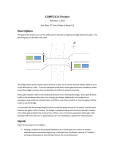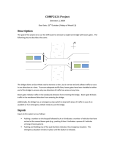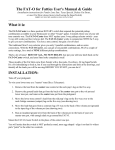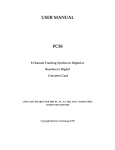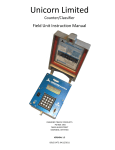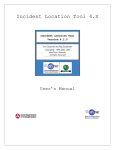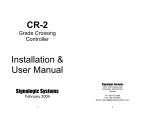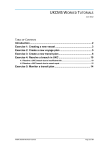Download COMP2121 Project Description Inputs
Transcript
COMP2121 Project Semester 1, 2010 Due Date: 4th June (Friday of Week 13) Description The goal of the project is to use the AVR board to simulate a single lane bridge with boom gates. The following picture describes the scene: The bridge allows an East-West road to traverse a river, but is narrow and only allows traffic to cross in one direction at a time. To ensure adequate traffic flow, boom gates have been installed at either end of the bridge to ensure only one direction of traffic has access at any time. Boom gate A blocks traffic in the eastbound direction from entering the bridge. Boom gate B blocks traffic in the westbound direction from entering the bridge. Additionally, the bridge has an emergency stop switch to stop both lanes of traffic in case of an accident or if an emergency vehicle needs to use the bridge. Inputs Inputs to the system are as follows: • • Pushing a number on the keypad followed by A or B indicates the number of vehicles that have arrived at the named boom gate (e.g., pushing 4 then A indicates a queue of 4 vehicles arriving at boom gate A). Pushing and holding one of the push buttons indicates the emergency situation. The emergency situation remains in place until the button is released. Protocol The boom gates and vehicles should operate under the following protocol: • • • • • • • • • • • At startup, you may assume no vehicles are in the vicinity of the bridge. Whenever there are no vehicles waiting at either side of the bridge, both boom gates will close. If there are vehicles on only one side of the bridge, the boom gates will transition to let that direction of traffic through. If their boom gate is open, vehicles will enter the bridge at a rate of 1 vehicle per second. It is safe to assume that entering and leaving of cars is synchronized to the 1 second boundary. Each vehicle exits the bridge 5 seconds after entering it. To alleviate congestion, if one gate has been open for at least 7 seconds and there is a car waiting at the other boom gate, then the current boom gate will close and the other boom gate will open. Thus, in a fully congested situation, cars will go through the bridge in bursts of 7 cars from either side of the bridge. A boom gate will not begin opening while there are vehicles still on the bridge travelling in the other direction. Boom gates take 2 seconds to open and 2 seconds to close. Vehicles should not pass while they are opening or closing. It is assumed that a car enters the bridge immediately after a boom gate is open. When the emergency switch is pushed, boom gates will start closing immediately. However, the vehicles already on the bridge will continue as normal. In an emergency, boom gates will remain shut until the push button is released. Vehicles can still arrive at either end of the bridge during an emergency. Interface The following features must be present in the interface, although you are free to add additional information: • • • The LCD must be able to display: o The number of vehicles waiting on the boom gate A side of the bridge o The number of vehicles waiting on the boom gate B side of the bridge o The number of vehicles currently traversing thebridge o The state of both boom gates (open, closed, opening, closing). The motor will run at 80rps whenever either gate is opening and at 50rps when either gate is closing. Two LEDs should operate as traffic lights (red only) for the boom gates. They will switch off when the boom gate is open, indicating traffic may go. During an emergency, both LEDs will blink at a rate of 3 Hz (3 blinks per second). Bonus The following bonus feature can be impemented, but is not required to receive full marks for the project. In the case that the emergency button is pushed while a boom gate is opening, then the boom gate should properly simulate the amount of time it will take to close. E.g., if the gate had been opening for a quarter of a second, it should only take a quarter of a second to close. Submission information The following items should be submitted: 1. Source code via the subject webpage, and its printed copy. Your program should be well commented. 2. A printed copy of a user manual. The user manual describes how a user uses your bridge emulating system, including how to wire up the AVR lab board. Make sure you indicate which buttons perform each action and how the LED and LCD displays should be interpreted. 3. A printed copy of the design manual. The design manual describes how you design the single lane bridge emulating system. It must contain the following components. a. System control flow, describing the control flow of the system at the module level using a diagram. This also shows how and when you service the inputs. b. Data Structures, describing the main data structures used in the system. c. Algorithms, describing how you keep the state of the bridge and vehicles. d. Module specification, describing the functions, the input and the output of each module. Overall, a person with knowledge about the subject and board should understand how your system is designed after reading this design manual. Assessment of your project working on the AVR board will also be performed in week 13. Grading The project is worth 15% of your course mark and will be marked under the following criteria (which is approximate for now): • • • • Implementation (65%): o Adherence to specification o Implementation of all input/output functionality Code Style (10%): o Easy to read o Well documented User Manual (10%) o Accurately describes set up of board o Correctly describes functionality Design Manual (15%) o Adherence to specification o Readability and Completeness



